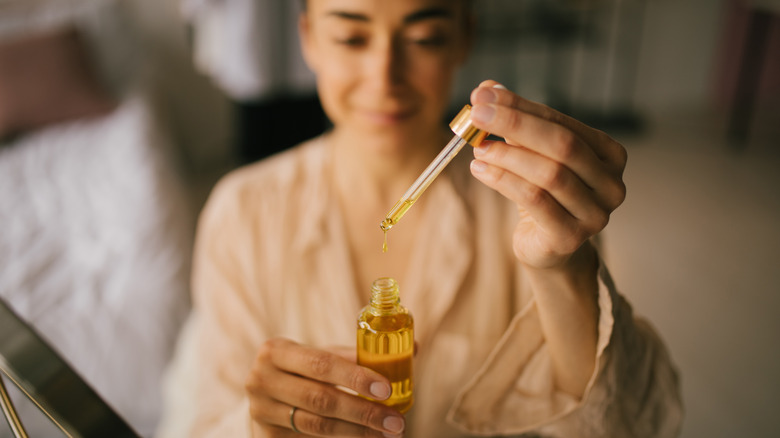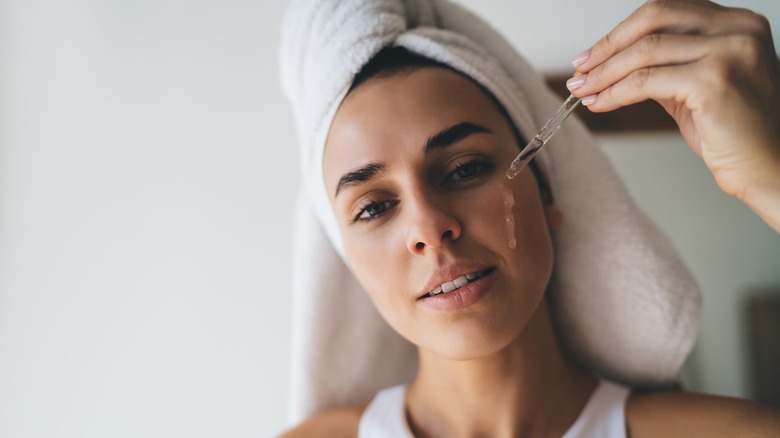How To Prevent Oily And Dry Patches With Oil Targeting, According To Our Dermatologist
We may receive a commission on purchases made from links.
If you've ever found yourself unable to determine your skin type, not quite fitting into one category or another, you likely know how confusing it can be to find a skincare routine that actually suits your skin. Each skin type requires a certain kind of care and specific products for nourishment and balance. Most fall into the categories of dry, oily, sensitive, and normal. But what if your skin falls into more than one category? If you have both oily areas and dry patches, often referred to as combination skin, then oil targeting might just be the technique for you.
To learn more about preventing oily and dry patches with the method, we reached out to New Jersey-based dermatologist Dr. Aanand Geria for an expert opinion. "Oil targeting is referring to the practice of applying skincare differently, depending on whether the specific part of the face is oily or not. For example, your T-zone may be oily so you might want to use a mattifying product just in that area but not on rest of your face because it could cause dryness," Dr. Geria tells Glam exclusively. Who knew the solution was so simple? The standard practice is to use a single product over the entirety of your face, whether or not it's beneficial for all areas of your skin, but it might just be time to take a different approach.
Using both moisturizing and mattifying products
Oil targeting is used to both manage and prevent patches of oiliness and dryness. " ... by using oil-absorbing products only on the areas of your skin that are actually oily, you can avoid unwanted shine," Dr. Aanand Geria explains in an exclusive conversation with Glam. "Likewise, using more hydrating or dewy products on drier skin like your cheeks can prevent dryness."
The good news is it's a super simple process and you can easily get it going at home. You may even already own some products that'll bring out your best skin, if used in a slightly different manner. Essentially, you're going to be using moisturizing products anywhere you tend to have dryness, like your cheeks. And if your nose and forehead are typically more oily, you'll want to reserve your mattifying products to balance out those areas. "It's very easy to get started at home," Dr. Geria says. "You can target oil in a variety of ways such as using a salicylic acid wash only on the oily zones but not the whole face, same thing for oil-absorbing wipes, and mattifying moisturizers ([for example] La Roche Posay Toleriane Double Repair Matte Moisturizer) and sunscreens ([for example] Supergoop Matte Screen)."
You can also use oil targeting to hop on the glowing, dewy skin trend. You'll simply want to apply a heavier oil and moisturizing ingredients to the areas you'd like to see really shine. "Conversely, to accentuate dewyness you can target the cheeks with marula oil, hyaluronic acid, and thicker emollients," Dr. Geria explains.
All skin types can benefit from oil targeting
If you're hesitant to try oil targeting and are unsure if it's right for your skin type, you can rest assured that the practice is safe. "Oil targeting is definitely safe for all skin types," Dr. Aanand Geria tells Glam exclusively. Those with combination skin are naturally the most likely to benefit from oil targeting as it addresses both oily and dry patches. But most of us do experience phases of dry skin during the colder months when we may be exposed to the wind and elements more — as well periods of fighting oilier skin in the heat and humidity of summer.
You may need to experiment as you go with the products that are best suited to your unique skin type and reorient your oil-targeting practice as your skin changes and fluctuates, like incorporating a cleansing oil into your skincare routine if hormones make your cheeks dry, for example. Ultimately, using a thicker facial oil on all of your skin may not yield the results you're hoping for, just as using drying products all over won't best serve your skin's health and radiance.


